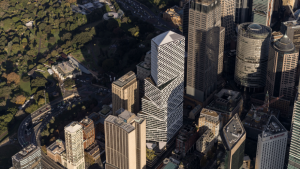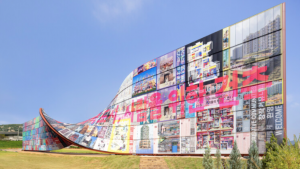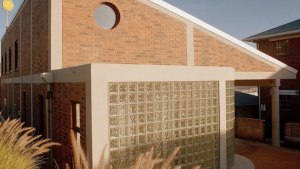They say that you only really know someone after you’ve travelled with them. Similarly, one could say that you only really know a place once you’ve travelled through it. We recently travelled through Ghana by road, taking in its beauty alongside the little nuances that define it.
Over the almost two weeks in August we drove through places along Ghana’s coast like Busua, Takoradi, Kumasi, Aburi, Koforidua, to name a few. We traveled by bus but one could easily have mistaken it for a rollercoaster, depending on how far back in the bus you were sat.
For someone coming from the neatly class-divided suburbs of Cape Town, the country’s urban nature was a lot to take in.
Those lines weren’t so clearly defined on this part of the continent.
The Ghanaian photographer Nana Kofi Acquah probably says it best: “When I look at Accra, I see a city that has an identity crisis. If you look at the city, there’s nothing that tells you where we were, where we’ve been, where we are, and where we’re going.”
It was interesting to have experienced this along the journey and juxtaposed it with the thoughts and opinions of a seasoned architect working in the country.
On our return to Accra, I met with architect and founder of Mustard, Alice Asafu-Adjaye at her studio in Abelenkpe, near the city centre.
“Are you on the tarred or untarred part of the road? We’re located on the untarred part,” she says as I finally give in to calling her for directions while sitting in a lost Uber.
Her studio is a respite from the heat outside, which she says they’re able to achieve without the use of any artificial cooling.
This is something, I came to learn, that is not always well considered in the making of Ghana’s buildings.
Born in Ghana, Asafu-Adjaye moved to the UK with her parents at age 14, where she went on to pursue degrees in architecture from Nottingham University and London’s Bartlett School of Architecture.
After cutting her teeth in some of the UK’s most acclaimed firms, including Foster and Partners as well as Adjaye Associates (no relation), she returned to her home country.
The decision to move back was a brave one considering how vastly different these two environments are.
But Asafu-Adjaye was provoked by the opportunities Ghana held rather than the challenges she could face learning and unlearning her own practice.
With more than 20 years in the industry, and now Africa and the Middle East’s representative on the RIBA Council, the architect is currently involved in the refurbishment of the Ghana National Museum.
She says this project is close to her heart as it so perfectly reflects the time in which it was built (1950s), and the ways that it complements its environment.
Her other projects include Project Eden, a residential retreat in Aburi, the KMDR mixed-use complex in Kumasi and the Devtraco town homes in Accra.
Something that strikes you as you go into Accra’s suburban areas is the juxtaposition of mansion-like buildings beside informal settlements.
She points this out too as she takes us out to her studio’s balcony.
“We’re surrounded by houses worth probably about a million dollars to shacks,” she says before elaborating on why the city finds itself this way.
She says it’s because there isn’t a synergy between what the community needs and what the built environment is right now, thanks to what she calls “ego-driven projects.”
It stems from a reluctance to consider the city and country’s unique characteristics and requirements and an inclination to replicate Western models.
This can be seen in the lavish constructions in areas like Airport Residential and East Legon for example.
She continues: “There are buildings that are way bigger than they need to be for however many occupants. They are not being designed to suit the environment within which they are. So you’re finding that a lot of buildings are poorly lit, they are being mechanically cooled.”
In ramblings over the course of the trip I encountered opinions from Ghanaians who too feel that these large homes, some of them often incomplete, have become more status symbol than building for need.
Asafu-Adjaye gained further insights into this through her study with the University of Ulster. The study on sustainability was undertaken through a partnership with Dr. Saul Golden at the University of Ulster and the CSIR (Council for Scientific and Industrial Research) in Ghana. It investigated elements such as corporate governance, sanitation, infrastructure and power. It’s an experience she found enlightening and exposed her, for the first time, to Ghana’s slums.
While rich and poor live side by side, Asafu-Adjaye feels that the poor are more responsive to the environment because their need merely extends to the basics of providing shelter.
“They’re not thinking of all the little add-ons, the aesthetic things that people learn from outside and slap on to their buildings. So, they’re looking to see ‘okay, I’m keeping the rain off, keeping the sun out and I want to keep cool’. They’re actually thinking harder,” she tells me.
It demonstrates that need transcends concept.
This is further amplified by the use of materials that are at hand like local mud and employing age-old techniques like thatched roofs and recessed windows to enable cross ventilation and adequate cooling. A vital consideration given the city’s soaring temperatures.
Having just seen this with fresh eyes through rural parts of Ghana, it’s clear that this is true beyond just the city of Accra. Further still, this persists for a number of developing African countries.
Acclaimed Burkinese architect Francis Diébédo Kere told us in 2011 on the Design Indaba Conference stage: “African architecture should stop copying the West, engage the real needs of the people and regard the environment.” Given the continent’s colonial history there is a sense of having to catch up with the Western world, but this cannot extend to the way we design our buildings.
Asafu-Adjaye drew the same conclusions after having completed work on the outskirts of the city. This informs her opinion that there’s an understanding one needs to have about the core, what really makes a habitable space, before one can start looking at what materials you’re using.
According to her, matters are further complicated by the disorderly approach of local authorities, which makes for a not-so-smooth design process. She says this means anything goes, which has its charms as it really locates you in Ghana. She elaborates: “It doesn’t become some sort of a vanilla city where you could be anywhere in the world.”
On the other hand though, the flipside of the charm is the negative effects such an “anything goes” approach can result in. For example, certain areas may be earmarked as unfit for habitation because of potential flooding. Ghana’s tropical climate means that when it rains it pours, often with torrential showers that can be pretty destructive. This results in larger societal issues such as disease and increased mortality in the event that floods occur.
Just as architects and urban planners have a role to play in engaging the communities and the environments within which they work, so too must the politicians shaping the built environment engage architects.
Asafu-Adjaye didn’t delve into the politics. But these sentiments have been raised before by Jeffrey Baller, professor and researcher on sustainable urban development. “Planning is not the problem, politics is,” he says.
He’s conducted research that demonstrates that Ghana’s poor urban scenario is not the result of a lack of planning, but rather a result of power struggles and political capture.
Despite these challenges it occured to me that Accra’s informal nature is part of what defines it. A big part at that. Like many other developing African cities, informal is the normal, and to most inhabitants, it seems that’s okay. It’s a city always in progress.
More on African cities:
Architect Sename Koffi Agbodjinou on building smart African cities








